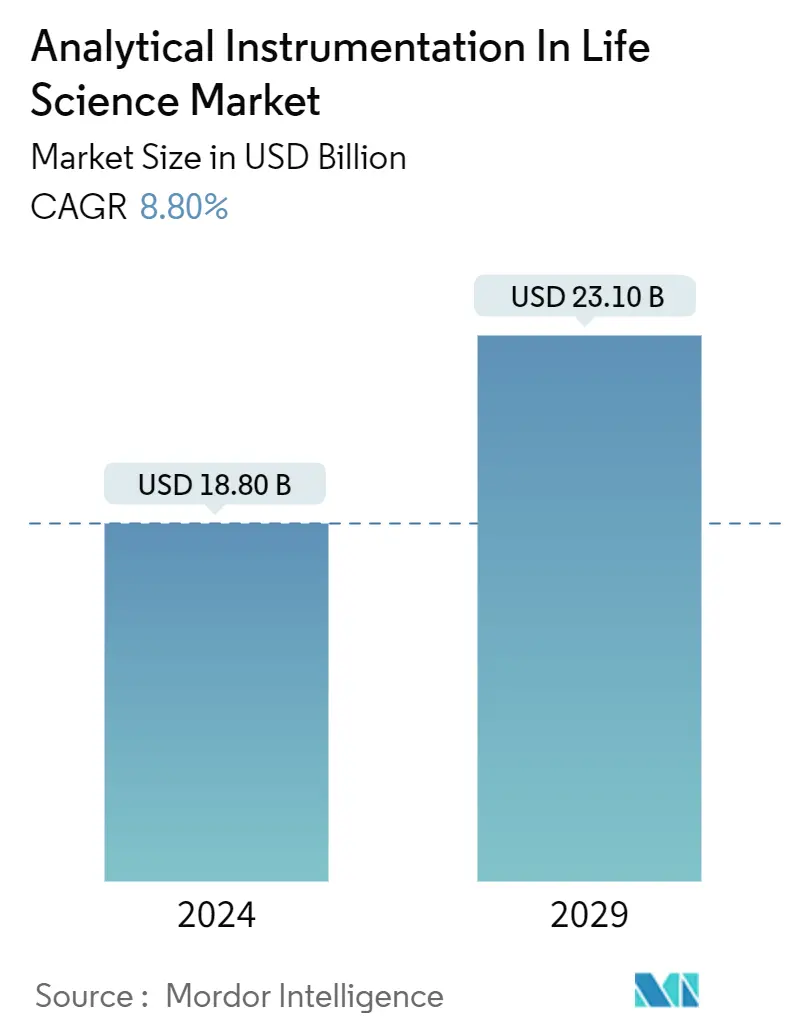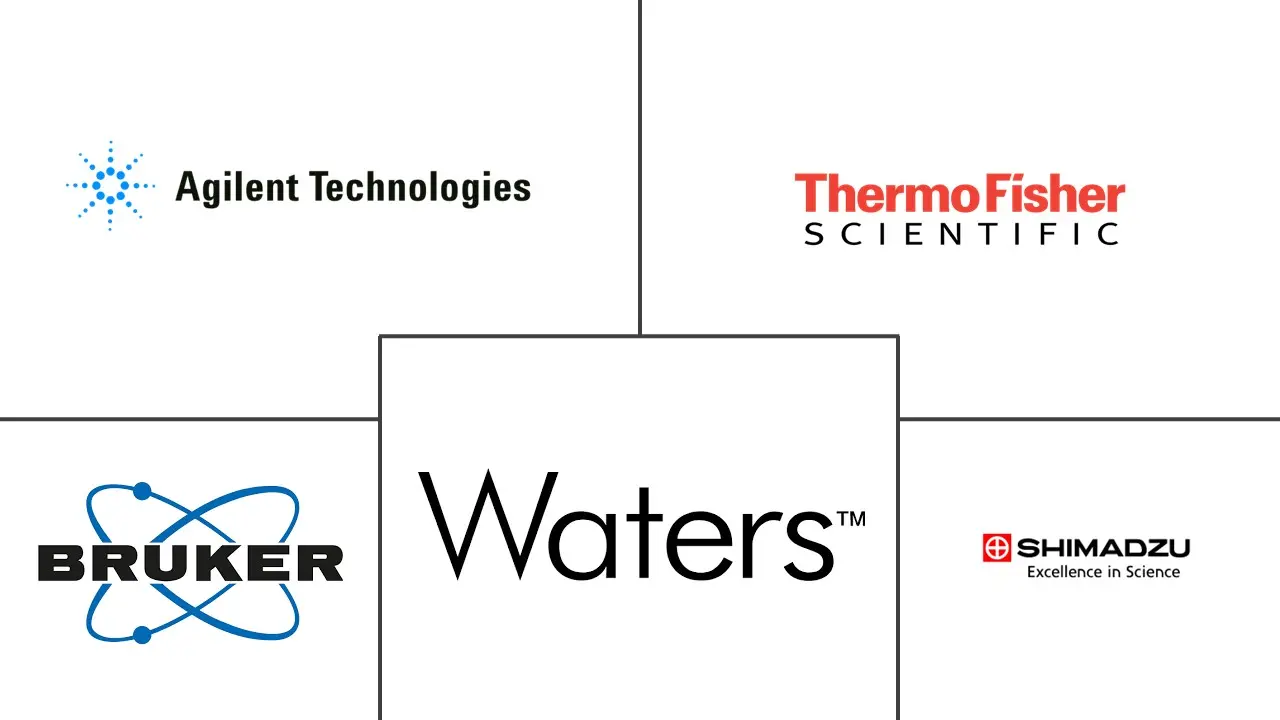Market Size of Analytical Instrumentation In Life Science Industry

| Study Period | 2019 - 2029 |
| Market Size (2024) | USD 18.80 Billion |
| Market Size (2029) | USD 23.10 Billion |
| CAGR (2024 - 2029) | 8.80 % |
| Fastest Growing Market | Asia Pacific |
| Largest Market | North America |
Major Players
*Disclaimer: Major Players sorted in no particular order |
Analytical Instrumentation In Life Science Market Analysis
The Analytical Instrumentation In Life Science Market size is estimated at USD 18.80 billion in 2024, and is expected to reach USD 23.10 billion by 2029, growing at a CAGR of 8.80% during the forecast period (2024-2029).
The increasing number of chronic diseases and viruses across developing and developed regions fuels the demand for analytics instrumentations in pharmaceuticals, medical devices, and biotechnology companies.
- The emerging diseases and viruses worldwide demand new medicines, creating new market opportunities for analytical instruments such as gas and liquid chromatography. These methods help professionals to identify a molecule with remedial properties. Similarly, it helps to analyze the existing medicines and alter the formulations to reduce side effects and improve results.
- The need to correctly analyze the chemical components in the drugs to accurately understand the number of ingredients and purity of the product increased the demand for gas chromatography across the pharmaceutical industry. Gas Chromatography helps in quality control for drugs before launching them. Drug manufacturers must follow the rules and regulations while developing drugs and need to prove their safety to regulatory agencies such as FDA. Thus, chromatography is gaining traction across drug manufacturing companies.
- The growing investment in the research and development of medicines, drugs, and vaccines contributes to market growth. For instance, in July 2022, the Department of Pharmaceuticals India set up 7 National Institutes of Pharmaceutical Education & Research (NIPERs) to foster and encourage quality and excellence in pharmaceutical research and education. An expenditure of INR 1,500 Crore (USD 183.42 million). Approved by the government to strengthen or upgrade these NIPERs for the period 2021-22 to 2025-26.
- The growing number of chronic diseases such as cancers, heart and lung infections fuels the drug demand worldwide. Government agencies such as the National Cancer Institute (NCI), medical research universities, and pharmaceutical companies are focusing on drug discovery and drug development. The growing spending on pharmaceuticals across U.S., Germany, Canada, and other countries creates demand for medicines and pharma products and is projected to boost the demand for analytical instrumentation.
- The COVID-19 pandemic forced the world population to stay at home, and lockdowns across the countries postponed the ongoing clinical trials and shifted focus towards vaccine trials and research and development on coronavirus. The supply chain disruption halted the production of instruments during the initial phase of the pandemic. The growing number of tests, vaccine trials, and R&D increased the demand for analytical instrumentation in the life science industry. The demand for medicines and drugs increased exponentially during the pandemic, accelerating market growth in the second half of 2020.
Analytical Instrumentation In Life Science Industry Segmentation
Analytical instrumentation in the life science industry helps analyze the materials, establish the composition, quality control, drug discovery, and research and development. The scope of the study includes the revenue accrued from the sale of various types of analytical instruments for various applications in the life sciences industry. This segment includes industries such as pharmaceuticals and biopharmaceuticals - establishments engaged in manufacturing medicinal and pharmaceutical products.
The analytical instrumentation market in the lifesciences industry is segmented by type of product (chromatographs, spectrometer (mass, elemental analysis, and molecular analysis), gas analyzer, liquid analyzer, and analytical x-ray instrumentation and analytical microscopes), end-user vertical (the biopharmaceutical and nutraceutical, and pharmaceutical) and geography (North America, Europe, Asia-Pacific, Rest of the World). The market sizes and forecasts are provided in terms of value in (USD) for all the above segments.
| By Type of Product | |
| Chromatographs | |
| Spectrometer (Mass, Elemental Analysis and Molecular Analysis) | |
| Gas Analyzer | |
| Liquid Analyzer | |
| Analytical X-ray Instrumentation and Analytical Microscopes |
| By End User Vertical | |
| Biopharmaceutical and Nutraceutical | |
| Pharmaceutical |
| By Geography | |
| North America | |
| Europe | |
| Asia-Pacific | |
| Rest of the World |
Analytical Instrumentation In Life Science Market Size Summary
The analytical instrumentation market in the life sciences sector is poised for significant growth, driven by the increasing prevalence of chronic diseases and the demand for new pharmaceuticals and vaccines. This market expansion is fueled by the need for advanced analytical techniques, such as gas and liquid chromatography, to ensure the quality and safety of drugs. These instruments play a crucial role in drug development by analyzing chemical components and aiding in the formulation of medicines with reduced side effects. The pharmaceutical industry, particularly in regions like Asia-Pacific, is witnessing a surge in research and development activities, supported by government initiatives and investments, which further propels the demand for analytical instrumentation.
The COVID-19 pandemic has also accelerated the growth of this market, as the need for rapid vaccine development and testing increased the reliance on analytical instruments. The integration of advanced technologies, such as artificial intelligence and machine learning, into analytical instrumentation is creating new opportunities for innovation and efficiency in laboratory settings. Major pharmaceutical companies are expanding their research and development capabilities in countries like India, which is becoming a hub for pharmaceutical research due to its favorable regulatory environment and cost-effective operations. The market is characterized by a semi-consolidated landscape, with key players focusing on product development and strategic collaborations to enhance their offerings and maintain a competitive edge.
Analytical Instrumentation In Life Science Market Size - Table of Contents
-
1. MARKET INSIGHTS
-
1.1 Market Overview (Current Scenario of Analytical Instrumentation in lifesciences industry and KPI Analysis)
-
1.2 Technological Trends
-
1.3 Supply Chain Analysis
-
1.4 Impact of macro trends (post-COVID-19 scenario, supply chain disruptions, and economic uncertainties among others) on the Market
-
1.5 Industry Attractiveness - Porter's Five Forces Analysis
-
1.5.1 Bargaining Power of Buyers/Consumers
-
1.5.2 Bargaining Power of Suppliers
-
1.5.3 Threat of New Entrants
-
1.5.4 Threat of Substitute Products
-
1.5.5 Intensity of Competitive Rivalry
-
-
-
2. MARKET SEGMENTATION
-
2.1 By Type of Product
-
2.1.1 Chromatographs
-
2.1.2 Spectrometer (Mass, Elemental Analysis and Molecular Analysis)
-
2.1.3 Gas Analyzer
-
2.1.4 Liquid Analyzer
-
2.1.5 Analytical X-ray Instrumentation and Analytical Microscopes
-
-
2.2 By End User Vertical
-
2.2.1 Biopharmaceutical and Nutraceutical
-
2.2.2 Pharmaceutical
-
-
2.3 By Geography
-
2.3.1 North America
-
2.3.2 Europe
-
2.3.3 Asia-Pacific
-
2.3.4 Rest of the World
-
-
Analytical Instrumentation In Life Science Market Size FAQs
How big is the Analytical Instrumentation In Life Science Market?
The Analytical Instrumentation In Life Science Market size is expected to reach USD 18.80 billion in 2024 and grow at a CAGR of 8.80% to reach USD 23.10 billion by 2029.
What is the current Analytical Instrumentation In Life Science Market size?
In 2024, the Analytical Instrumentation In Life Science Market size is expected to reach USD 18.80 billion.

